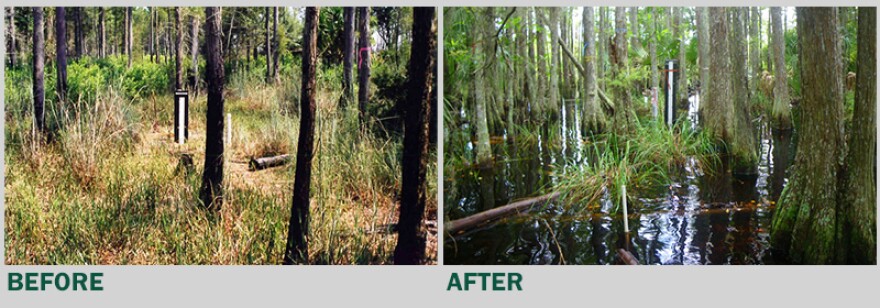It’s just past noon on a Friday, so the sun is beating down pretty hard at Lake Park in Lutz.
The blue sky and fluffy white clouds are reflecting on the surface of Lake Starvation, which is lined by lush greenery.
Earl Henning, a 72-year-old retired musician, has been fishing here for about 30 years.
“There we go. Come on little fishy,” he said, after his bait plops near some lily pads, creating ripples in the mirrored images.
These days he’s able to cast a line from the boat ramp, but that wasn’t always the case.
“If the water level is up like this, I could bring my truck and set my boat in by myself. But if the water level was like where it was before, you'd have to have a four-wheel drive, and a trailer to get the boat far enough out to get an inch of water to make it float,” Henning said.

Why lakes were depleted
A couple decades ago, the water was so low you’d have to trek through dry dirt, cattail grass and fishbones before getting to the water line.
The culprit? Way too much drinking water was being pumped out of a nearby well, depleting the water table that feeds the lake.
“Lake Starvation — that's a great name for it because if you thought you were going to catch a fish and eat, you were going to starve,” he said.
And this was happening to lakes and wetlands near well fields all across the greater Tampa Bay region.
"In the mid-1990s … there were a lot of lakes and wetlands that had zero water for long periods of time. That causes damage to the vegetation, the animals move away, and it can change the structure of the wetlands underneath," said Warren Hogg, who’s been with the utility Tampa Bay Water and its predecessor for 36 years.





The end of the 'water wars'
Groundwater was the primary source of drinking water for the region back then and municipalities were fighting over it.
Some would even buy well fields outside of their jurisdictional boundaries to meet their growing needs.
There was also economic disparity among municipalities because some that owned well fields for decades could sell water at inflated rates to those that didn't.
So, on June 10, 1998, the municipalities got together and agreed to form Tampa Bay Water to end “the water wars.” It acquired the wellfields from the municipalities and began charging each member the same price for water.
It currently supplies water to Hillsborough, Pinellas and Pasco counties; as well as the cities of Tampa, St. Petersburg and New Port Richey.
"We hit a maximum of 160 million gallons a day from these well fields. We're now down to less than 80,” Hogg said. “But we developed two river water sources, a desalination plant and a reservoir as our water savings account. That not only replaced the water we didn't take out of the ground, it's allowed us to keep up with the current growth that's come since then."
Tampa Bay Water is currently expanding its surface water treatment plant to account for that growth in the region, especially in Pasco and southern Hillsborough counties.
The utility has a master plan looking ahead 20-plus years.
“This plan looks at additional groundwater where it might be available. We look at river water, we look at desalinated seawater, and maybe someday down the road using reclaimed water in some manner as a water supply project," Hogg said.
More than 550 lakes and wetlands across the greater Tampa Bay region have rebounded as a result of the utility finding alternate water resources.
The project is considered a total success.
Below is Tampa Bay Water's recovery assessment final report:
Earl Henning said he can see the drastic recovery at Lake Starvation.
“I see a lot more of the lily pads and the things that the bass and stuff need, which is my fish,” he said. “I'm glad that the people got rid of the politics and decided that what's really important is the lakes and that this is a park. This is for people to come in and enjoy ... It's not for two guys to stand there and ‘argue it's my water, it's your water.’ You know, get off of that.”
Henning calls this place his sanctuary because he says as soon as the bait hits the water, the rest of the world just disappears.
As Tampa Bay Water celebrates its 25th anniversary on Saturday, it pledges to keep protecting natural resources like this one, even as the demand for water continues to grow.





